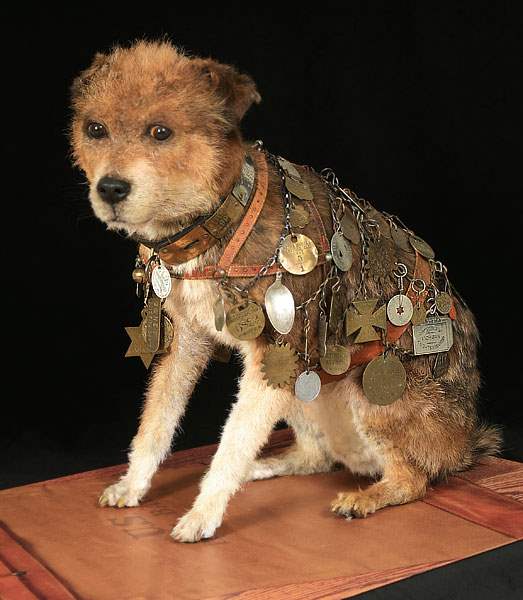
CULTURE SHOCK
419 Day marks city's rich history
4/12/2018
Owney at the Smithsonian. An Irish terrier mix who traveled the globe, Owney met his end in Toledo in 1897.
SMITHSONIAN
419 Day is a celebration of the now and what's to come in northwest Ohio.
419 History Day on Saturday at the Toledo Lucas County Public Library’s main location is a celebration of the oh-so-colorful past that got us here.
Like the time Toledo killed Lassie — at least, the late 1800s canine equivalent, a beloved and famous mutt named Owney.

Owney at the Smithsonian. An Irish terrier mix who traveled the globe, Owney met his end in Toledo in 1897.
An Irish terrier mix that more closely resembled Benji than that of the Rough Collie Lassie, Owney was the unofficial mascot of the country’s Railway Post Office and traveled along the rails as a good luck charm; he was never aboard a train that crashed.
Owney’s travels, including a worldwide trip, brought him headlines and fame in cities and towns around the globe.
A local postal clerk undoubtedly wanted to seize on the media opportunity when Owney came to Toledo in June 11, 1897. Unfortunately, Owney did the seizing, biting the worker for reasons we’ll never know. The police were called, Owney was taken into custody, and ordered to be executed. The next day the nation’s first famous pooch was shot by a police officer in the alley behind the police station.
It's all chronicled by local historian and longtime journalist Lou Hebert in his blog toledogazette.wordpress.com and book, Day by Day in Toledo, about Toledo's history.
“Not only was he shot and killed in Toledo by Toledo police,” Hebert said in an interview earlier this week, “the next day they realized maybe we shot Lassie, so they had him stuffed by a Toledo taxidermist and sent back to his home base in Albany (N.Y.), who then sent him to the Smithsonian,” where the dog is prominently display, after a recent clean up and remounting.
This being Toledo, the story only gets stranger from there.
“Believe it or not, they brought the dog back to Toledo in the 1930s,” Hebert said. “The postal workers were having a big postal convention in Perrysburg and they brought the stuffed dog back for the postal workers to see.”
The Owney incident is one of many nearly forgotten quirky pieces of Toledo’s past that Hebert will share in his 1 p.m. presentation as part of 419 History Day, which runs from 1 to 4.
Not sexy enough? How about the story of Round the Clock Grille in Ottawa County, perhaps the most (in)famous brothel in the Midwest, which “operated pretty openly for about 20 years before it was raided and busted” in 1972.
It was actually one of the first stories Hebert covered as a cub news reporter for an AM news station and, as he said, still carries a lot of local interest.
“I probably get more questions about that than anything else,” he said.
But not everything about Toledo’s past is quirky or unpleasant. In fact, the city’s history is one of prominence — not just in the region but in the country.
“One of the things I’ve learned in my research of history is that up through World War II Toledo was a major player” in industry, entertainment, and social reform.
“Toledo was on the cutting edge of being a progressive city, but somewhere along the way, after World War II ... the bloom fell off the rose” as dramatic population shifts favored cities and suburbs, particularly in warmer climates, and the manufacturing industry began to struggle.
Before the decline, Toledo was home to “a lot of people who had great vision ... a lot of great inventors, a lot of people who were real entrepreneurs, people who just had some sort of courage and vision.”
That’s what 419 Day is really about, anyway, the people of the 419 who made the city great and are making it even better now. The city’s history, in other words, is relevant to its present and its future.
“You’re talking to somebody who believes there’s a great future in history,” Hebert said. “And what we live in today is part of that, the fruit of that.
“We have some great roots here.”
And some crazy stories too.
Contact Kirk Baird at kbaird@theblade.com or 419-724-6734.